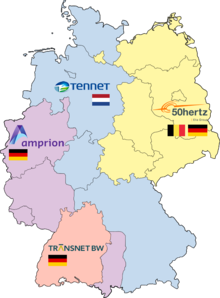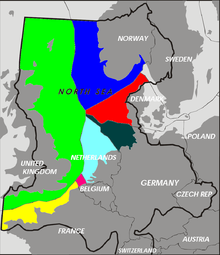TenneT
| Company type | Government-owned limited liability company (BV) |
|---|---|
| Industry | Electricity |
| Founded | 1998 |
| Headquarters | , |
Number of locations | 435 (Substations) |
Area served | Netherlands Germany |
Key people | Manon van Beek CEO |
| Services | Electric power transmission |
| Revenue | € 4,176 million (2018) |
| Total assets | € 21,783 million (2018) |
| Owner | Dutch Ministry of Finance |
Number of employees | 3,409 (2018) |
| Subsidiaries |
|
| Website | www |
TenneT is a transmission system operator in the Netherlands and in a large part of Germany.
TenneT B.V. is the national electricity transmission system operator of the Netherlands, headquartered in Arnhem. Controlled and owned by the Dutch government, it is responsible for overseeing the operation of the 380 and 220 kV high-voltage grid throughout the Netherlands and its interconnections with neighbouring countries. It is additionally responsible for the 150 kV grid in South Holland.
In Germany, its subsidiary TenneT TSO GmbH is one of the four transmission system operators. Formerly named Transpower, it was taken over and renamed in 2010.
As of 2006, it operates 3,286 km of lines and cables at 150 kV and above, connecting at 51 high-voltage substations.[1] Peak demand for 2006 was 14,846 MW.[1] The sole shareholder is the Dutch Ministry of Finance.
History
[edit]| External images | |
|---|---|
| TenneT grid maps | |
TenneT was formed in 1998 when the Dutch electricity industry was liberalised, and was incorporated as a business in 2001 with the passing of the Electricity Production Sector Transition Act.[2] Its statutory tasks included management of the national transmission grid and maintaining the balance between electrical supply and demand. In 2003, it acquired the regional system operator Transportnet Zuid-Holland.[2]
TenneT moved beyond these regulated businesses in 2004 when it entered the gas market by acquiring EnergieKeuze, an online gas and power contract exchange market.[2] In 2005 TenneT further expanded its operations when, together with the Belgian and French TSOs Elia and RTE and the APX and Powernext power exchanges, it formed the Belgian Power Exchange Belpex. This granted it a right to participate in the Belgian electricity market.[2]

Since 1 January 2010, Tennet owns the German high‑voltage grid operator Transpower Stromübertragungs GmbH, formerly a part of E.ON, now renamed to Tennet TSO GmbH. The agreed value of transaction was €885 million. The company quoted several reasons for the merger, including price equalization, improved grid balancing, greater insight into grid situations, and better possibilities for sustainable development in both countries.
On 1 March 2018, the European Commission opened a formal antitrust investigation against TenneT, alleging it was deliberately bottlenecking the grid connection between Denmark and Northern Germany, preventing cheap wind and hydro power from Scandinavia from being exported to the German market. The Commission adopted a decision on 7 December 2018, imposing binding obligations on TenneT to allow at least 75% of the capacity to be utilized after a 6-month implementation period, as well as to expand the connection capacity from 1300MW to 2625MW by January 2026.[3][4]
Early 2023, Tennet announced that the Dutch and German governments were discussing a potential sale of the Germany grid of Tennet for a price of €22 billion, as the Dutch government was reluctant to provide the growing investment cost for the German grid.[5] The sale was abandoned in 2024, due to the German government lacking the required budget. In the meantime the Dutch government had provided the company a €25 billion loan.[6]
TenneT is a partner in European Market Coupling Company.
DC links
[edit]In 2006, TenneT entered into construction of the 700 MW NorNed undersea HVDC submarine power cable with the Norwegian transmission operator Statnett. Commercial operation of the link was delayed by poor weather and a break in the cable, but it eventually entered operation on the night of 6 May 2008.[7] Connecting the Norwegian and Dutch grids at Feda and Eemshaven, the ±450 kV bipolar cable is, at 580 kilometres (360 mi), the longest undersea power line in the world.[8] During the first two months of test operations, it generated approximately €50 million in revenue, greatly exceeding estimates, and recovering 12% of its cost of construction.[9]
TenneT formed a joint venture with the British transmission operator National Grid to construct the 260-kilometre (160 mi) 1,000 MW BritNed HVDC link between the Isle of Grain, Kent and Maasvlakte, near Rotterdam.[10] Operations begain on 1 April 2011,[11][12] and as of January 2012, electricity flow has mostly been from the Netherlands to the UK.[13] The BritNed interconnection is seen as a vital link for the foreseeable European super grid project.
A 700MW submarine power cable called COBRA (like NorNed, also from Eemshaven) to Denmark is operated with Energinet.dk[14] from 2019, signing contracts with Siemens and Prysmian in 2016.[15] Further 3½ GW offshore DC links are intended to provide a sea grid structure, and 6½ GW AC links are planned between Netherlands and Germany.[16]
Its subsidiary Transpower Stromübertragungs together with Statnett operates the 1400MW NORD.LINK cable between Norway and Germany from 2020.[17]
TenneT builds the 2 GigaWatt SuedLink, an onshore DC link between Hamburg and south Germany (near Frankfurt), but local opposition means that a timeline is unclear.[18] Both SuedLink and NORD.LINK are on the EU "Projects of Common Interest" list, and SuedLink is supported by EU with €40 million.[19][20][21]
TenneT plans onshore AC upgrades in North Germany, connecting new wind power to some of the above DC links.[22]
Dogger Island
[edit]
In 2016, TenneT suggested a 6 km2 artificial island in the Dutch corner of the Dogger Bank in the middle of the North Sea, connecting several GigaWatts of offshore wind farms with alternating current. Converters on the island would then transmit direct current to the countries around the North Sea in a more economic manner than if each wind farm had its own cable to the country building it.[23][24] TenneT called for feasibility studies in 2017,[25] and signed an agreement with Energinet.[26] The challenge of coordinating several DC links is studied by the Technical University of Denmark using the Kriegers Flak connector as an example.[27]
Suedlink
[edit]You can help expand this section with text translated from the corresponding article in German. (June 2023) Click [show] for important translation instructions.
|
In Germany, most of the wind-power generation is located in the North, while most of the solar power plants are in the South. As of 2023[update], cases of deficit of wind power in the North require using gas and coal powered power plants, even if the solar power is abundant in the South, and vice versa. To allow for a more robust redistribution of electricity, an almost 700 kilometer high-voltage direct current transmission line called "Suedlink" (sometimes spelled "Südlink") is planned to be built, connecting North of the country to its South. The overhead power line was originally planned to be finished in 2022. However, amid protest from local residents, the plan had to be converted to an underground power delivery system, and scheduled to be finished in 2028.[28] It is expected to provide four gigawatts of electricity to around 10 million households.[29]
The new plan continues to be protested by residents and land owners close to the route of the line. Opponents of the power line cite damage to the environment and habitat, loss of the development opportunities for the local communities as arguments against it.[30] Demonstrators' claim is that instead of big distributors like TenneT, Germany should rely more on a decentralized system of photovoltaics, wind energy and hydrogen.[29]
See also
[edit]References
[edit]- ^ a b Key figures, TenneT, archived from the original on 2007-10-30, retrieved 2008-02-08
- ^ a b c d Cohen, M. (2006), International Directory of Company Histories, vol. 78, St. James Press, ISBN 978-1-55862-582-2
- ^ "Antitrust: Commission imposes binding obligations on TenneT to increase electricity trading capacity between Denmark and Germany". European Commission. Retrieved 29 December 2019.
- ^ "EU tells German grid operator TenneT to raise access for Nordic power". Reuters. 7 December 2018. Archived from the original on December 7, 2018. Retrieved 29 December 2019.
- ^ "'Nederland dichtbij verkoop TenneT Duitsland'". FD.nl (in Dutch). Retrieved 2024-06-20.
- ^ "Overheid loopt miljarden mis; verkoop TenneT Duitsland gestaakt". bnr.nl (in Dutch). Retrieved 2024-06-20.
- ^ NorNed: Progress, TenneT, retrieved 2008-02-12
- ^ "Closing the Baltic ring", Modern Power Systems, 28 July 2006
- ^ "World's longest subsea high-voltage link opened", The Norway Post, 12 September 2008, retrieved 2 October 2008
- ^ "BritNed Submarine HVDC Cable To Connect UK And The Netherlands", Power Online, retrieved 2 October 2008
- ^ Paulsson, Lars (2011-02-24). "Dutch, U.K. Regulators Approve BritNed Power Cable Trading". Bloomberg. Retrieved 2011-03-11.
- ^ "BritNed cable electrically connects United Kingdom and the Netherlands" (Press release). TenneT. 2011-04-01. Archived from the original on 2016-05-10. Retrieved 2016-05-10.
- ^ Justin Wilkes et al. The European offshore wind industry key 2011 trends and statistics p22 European Wind Energy Association, January 2012. Accessed: 26 March 2012.
- ^ "Planned electricity cable between the Netherlands and Denmark". TenneT. Retrieved 24 September 2010.
- ^ Siemens and Prysmian will build the COBRA interconnection between Denmark and the Netherlands Archived 2016-02-02 at the Wayback Machine Energinet.dk, 1 February 2016.
- ^ "TenneT to invest billions to accommodate interconnectors and offshore wind".
- ^ "Statnett and E.ON mull Norway-Germany subsea cable". Power Engineering International. PennWell Corporation. 2008-01-10. Retrieved 2008-01-13.
- ^ "SuedLink - TenneT".
- ^ "EU invests €444 million in key energy infrastructure". European Commission. 17 February 2017. Retrieved 26 February 2017.
- ^ Projects of common interest (PCI) page 5
- ^ "Wind power line SuedLink to be equipped with Siemens Energy HVDC technology". www.windtech-international.com.
- ^ Leitungsbauprojekte in Schleswig-Holstein Archived 2016-04-13 at the Wayback Machine (Stand: Oktober 2015)
- ^ "TenneT unveils vision for wind energy island 'hub' in North Sea". businessgreen.com. 13 June 2016. Retrieved 10 August 2016.
- ^ "North Sea Infrastructure". TenneT. Archived from the original on 2017-03-08. Retrieved 10 August 2016.
- ^ "TenneT tenders for artificial Island". 4c Offshore. 14 February 2017. Retrieved 23 February 2017.
- ^ "First meeting of North Seas Energy Forum". European Commission. Retrieved 23 March 2017.
- ^ "New Danish Project to Support TenneT's Power Link Concept". 18 April 2017. Retrieved 19 April 2017.
- ^ Rohwer-Kahlmann, Malte (2 June 2023). This is what's REALLY holding back wind and solar (Television production). Deutsche Welle – via YouTube.
- ^ a b "Demonstration gegen Stromtrasse Südlink in Südthüringen | MDR.DE". www.mdr.de (in German). Mitteldeutscher Rundfunk. 9 October 2022. Retrieved 3 June 2023.
- ^ Bräuer, Jan (6 December 2021). "Südlink steckt weiter in der Planungsphase | MDR.DE". www.mdr.de (in German). Mitteldeutscher Rundfunk. Retrieved 3 June 2023.
External links
[edit]- Official website (in English)
